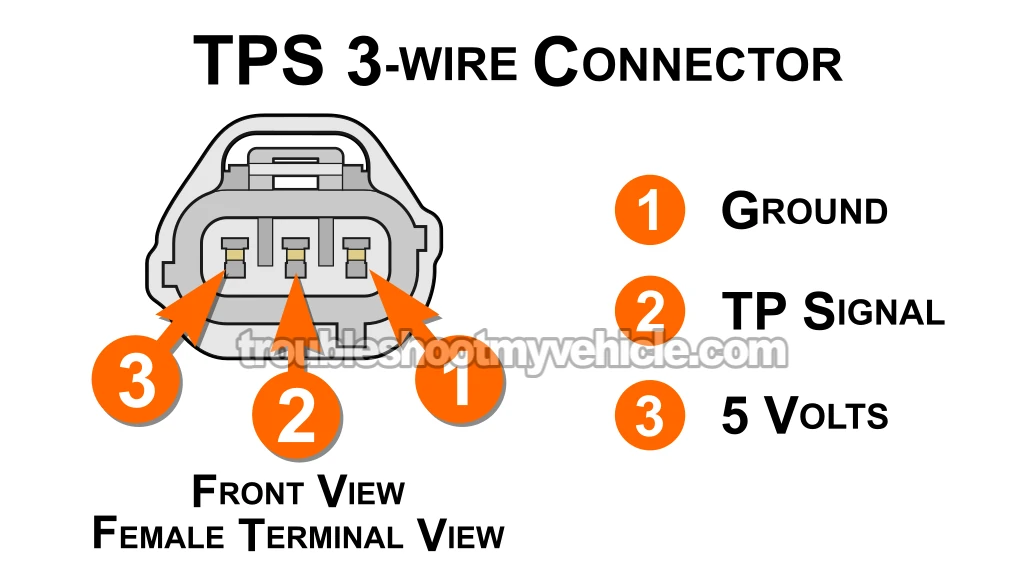
One of the easiest sensors to test on your 1997-2003 V8 Dodge Ram van is the throttle position sensor (TPS). The best part? You won't need any high-end scan tools to get it done!
In this guide, I'll take you step-by-step through the entire testing process. It's a pretty easy procedure —and with just three basic checks, you'll be able to determine whether your TPS is doing its job or if it's time for a replacement.
Contents of this tutorial:
APPLIES TO: This tutorial applies to the following vehicles:
- Dodge Ram 1500 Van 5.2L V8: 1997, 1998, 1999, 2000, 2001, 2002, 2003.
- Dodge Ram 2500 Van 5.2L V8: 1997, 1998, 1999, 2000, 2001, 2002, 2003.
- Dodge Ram 3500 Van 5.2L V8: 1997, 1998, 1999, 2000, 2001, 2002, 2003.
- Dodge Ram 1500 Van 5.9L V8: 1997, 1998, 1999, 2000, 2001, 2002, 2003.
- Dodge Ram 2500 Van 5.9L V8: 1997, 1998, 1999, 2000, 2001, 2002, 2003.
- Dodge Ram 3500 Van 5.9L V8: 1997, 1998, 1999, 2000, 2001, 2002, 2003.
OTHER TPS SENSOR TESTS:
- How To Test The TPS (1989-1990 5.2L, 5.9L V8 Dodge Ram Van).
- How To Test The TPS (1991 5.2L, 5.9L V8 Dodge Ram Van).
- How To Test The TPS (1992-1997 5.2L, 5.9L V8 Dodge Ram Van).
Symptoms Of A Bad Throttle Position Sensor
If your throttle position (TP) sensor fails, you'll likely run into one or more of the following problems:
- Diagnostic Trouble Codes (DTCs): These trouble codes will trigger the check engine light (CEL) when the TPS is acting up:
- P0121: TPS Signal Doesn't Match What The MAP Sensor Is Reading.
- P0122: TPS Signal Voltage Is Reading Too Low.
- P0123: TPS Signal Voltage Is Coming In Too High.
- Engine refuses to start: No matter how long you crank it, the engine just won't fire up.
- Hard to start: You have to crank the engine multiple times before it finally comes to life.
- Engine stumbles or hesitates: A brief pause or hesitation when you press the accelerator, either from a full stop or while already driving at steady speed.
- Loss of power: The engine doesn't respond like it used to when you press the gas, especially noticeable when starting off or accelerating on the highway.
- Terrible fuel economy: The computer enters "limp-in" mode to protect the engine, dumping in extra fuel and limiting performance. As a result, your MPG drops significantly.
How The Throttle Position Sensor Works
As you probably know, the accelerator pedal connects to the throttle plate using a mechanical linkage called the accelerator cable.
The throttle plate itself is a butterfly-style valve whose main role is to control how much air flows into the engine.
Here's a quick breakdown of how the system works:
- Stepping on the accelerator: When you press down on the pedal, the throttle plate swings open, letting more air into the intake system.
- Letting off the accelerator: As you release the pedal, the throttle plate closes back up, restricting airflow into the engine.
The fuel injection computer keeps constant tabs on the throttle plate's position using the throttle position sensor (TPS). This sensor tracks how far the plate opens or closes as you work the gas pedal.
The TPS generates a direct current (DC) voltage that changes depending on the position of the throttle plate:
- Throttle closed: The voltage signal is low—usually somewhere between 0.3 to 0.9 Volts DC.
- Opening the throttle: As the plate opens up, the voltage smoothly rises.
- At Wide Open Throttle (WOT): The TPS typically sends out a voltage close to 4.5 Volts DC.
- Closing the throttle: The signal voltage drops again, returning to the lower range associated with idle or closed throttle.
Where To Buy The TPS And Save
The following links will help you to comparison shop for the TPS for your V8 Dodge Ram van. I think they'll save you a few bucks:
If you're unsure if this TPS is compatible with your specific V8 Dodge Ram van, no worries. Once you visit the site, they'll check and ensure it's the right one by asking for more details about your vehicle. If it doesn't fit, they'll help find the correct one.
TEST 1: Testing The TPS Voltage Signal
The very first step is to measure the TPS signal voltage while manually opening and closing the throttle plate.
To do this, we'll connect to the center wire on the TPS's 3-wire connector. This is the orange with dark blue stripe (ORG/DK BLU) wire of the connector.
To put it simply, if the TPS is faulty, the voltage reading will stay the same no matter how much you move the throttle —it won't rise or fall like it should.
NOTE: You'll need a multimeter for this test. If you don't already have one, here's the one I personally use and recommend: Tekpower TP8268 AC/DC Auto/Manual Range Digital Multimeter (at: amazon.com).
IMPORTANT: To measure the TPS voltage correctly, the sensor must stay connected to its 3-wire engine wiring harness connector. You'll need to back-probe the connector or use a wire-piercing tool to tap into the signal wire without disconnecting anything. For a visual of this tool (and where to buy it), check out this link: Wire Piercing Probe.
Follow these steps:
- 1
Attach the black multimeter lead to the battery's negative terminal.
- 2
Switch your multimeter to DC voltage mode.
- 3
Turn the ignition key to the ON position, but don't start the engine.
- 4
Connect the red multimeter lead to the signal wire —that's the orange with dark blue stripe (ORG/DK BLU) wire.
This is the center wire on the TPS connector.
NOTE: Leave the sensor plugged in while testing. - 5
With the throttle fully closed, your multimeter should show a voltage between 0.3 and 0.9 Volts DC.
If the reading is outside this range or shows nothing, don't worry —continue to next step. - 6
Manually open the throttle plate from under the hood.
NOTE: Do not use the gas pedal for this test. Rotate the throttle body linkage by hand instead. - 7
As you gradually open the throttle, the voltage should rise smoothly.
- 8
At full throttle, expect a voltage reading between 3.5 and 4.5 Volts DC.
- 9
Now close the throttle slowly.
- 10
The voltage should drop back down to the initial reading from when the throttle was fully closed.
- 11
Tap the TPS lightly with the handle of a screwdriver as you open and close the throttle plate.
A working TPS won't be affected by the tapping. But if the voltage signal jumps or cuts out, the sensor is faulty.
Let's break down what your test results mean:
CASE 1: Voltage signal responded as expected. Great news! That means the TPS is functioning properly.
It also confirms that the sensor is receiving proper power and Ground from the fuel injection system. In short, both the sensor and its circuit are working just fine.
CASE 2: Voltage stayed the same and didn't change at all. This usually points to a failed TPS.
To be sure, we'll need to confirm that the sensor is actually getting power and Ground. Move on to: TEST 2: Making Sure The TPS Is Receiving 5 Volts.
CASE 3: No voltage reading at all. This typically means one of two things —the sensor is either dead or not receiving the voltage or Ground it needs.
The next step is to confirm whether power is reaching the sensor. Go to: TEST 2: Making Sure The TPS Is Receiving 5 Volts.





